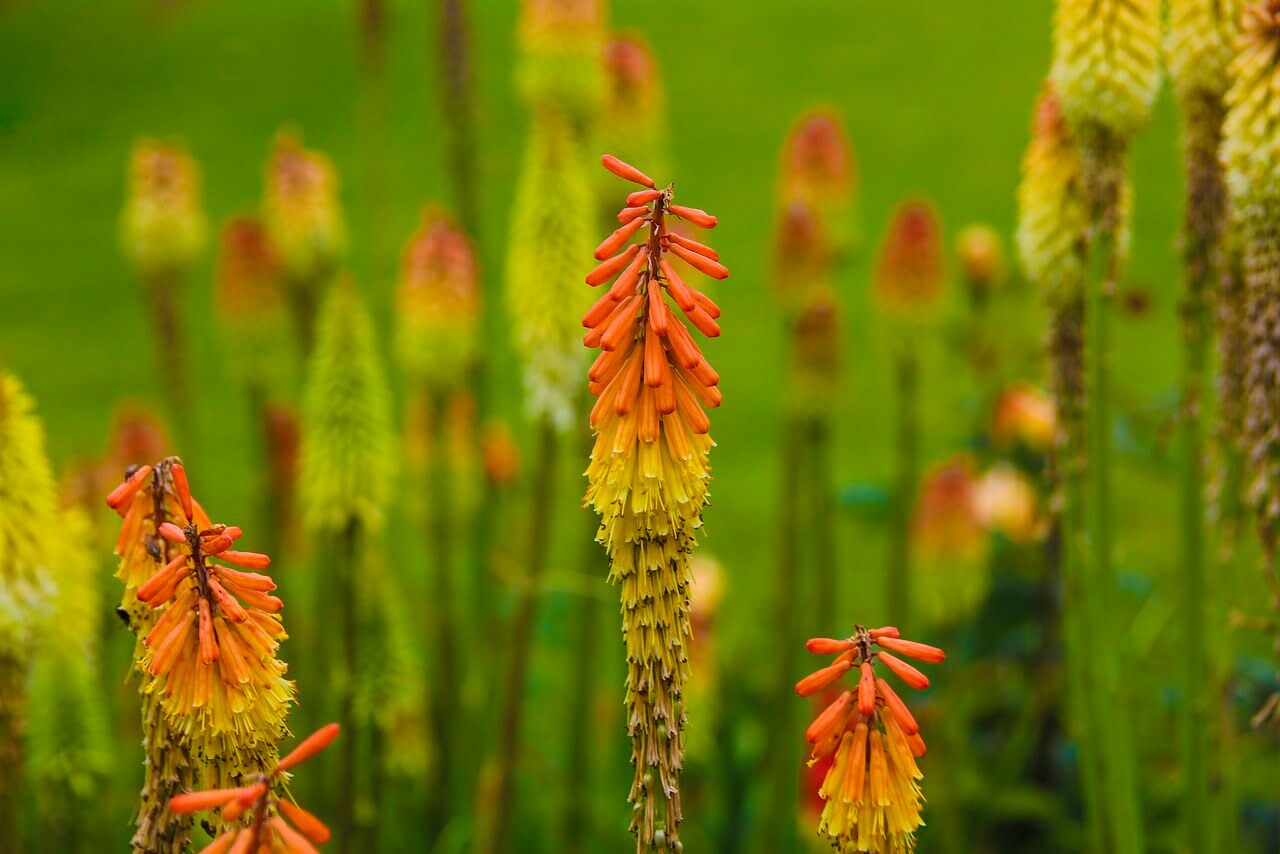
Growing Vibrant Red Hot Poker Flowers
Introduction
In this article, we’ll explore the Growing Vibrant Red Hot Poker Flowers(Kniphofia), a stunning and vibrant flower known for its unique appearance and ability to attract pollinators. Whether you’re an experienced gardener or just starting, we’ll provide you with a step-by-step guide on how to grow these eye-catching flowers in your garden successfully.
Table of Contents
- What are Red Hot Pokers?
- Choosing the Right Red Hot Poker Varieties
- Selecting the Perfect Planting Spot
- Preparing the Soil for Planting
- Planting Red Hot Poker Bulbs
- Caring for Your Red Hot Pokers
- 6.1. Watering Tips
- 6.2. Fertilizing Guide
- 6.3. Mulching Benefits
- 6.4. Pest and Disease Control
- Propagation Methods
- Dividing and Transplanting Red Hot Pokers
- Red Hot Poker Companion Planting
- Using Red Hot Pokers in Landscaping
- Common Red Hot Poker Varieties
- 11.1. Kniphofia Uvaria (Torch Lily)
- 11.2. Kniphofia Caulescens (Winter Poker)
- 11.3. Kniphofia ‘Mango Popsicle’
- 11.4. Kniphofia ‘Alcazar’
- Red Hot Pokers in Wildlife Gardens
- Tips for Overwintering Red Hot Pokers
- Pruning Red Hot Pokers
- Frequently Asked Questions (FAQs)
1. What are Red Hot Pokers?
Red hot pokers, also known as torch lilies or poker plants, are perennial flowers native to South Africa. They belong to the Kniphofia genus and are prized for their striking, torch-like inflorescence in vibrant colors like red, orange, and yellow. These flowers are not only visually appealing but also serve as nectar-rich beacons for pollinators, such as hummingbirds and butterflies.
2. Choosing the Right Red Hot Poker Varieties
When selecting red hot poker varieties for your garden, consider factors like climate, sunlight exposure, and available space. Some popular cultivars include ‘Royal Standard,’ ‘Papaya Popsicle,’ and ‘Sunningdale Yellow.’ Choose varieties that are best suited to your local climate and garden conditions.
3. Selecting the Perfect Planting Spot
Red hot pokers thrive in full sunlight, so choose a location in your garden that receives at least six hours of direct sunlight each day. Ensure the spot has well-draining soil to prevent waterlogging, which can be detrimental to the plants’ health.
4. Preparing the Soil for Planting
Before planting, enrich the soil with organic matter like compost or well-rotted manure. This will improve soil structure, drainage, and nutrient content, creating an ideal environment for your red hot pokers to flourish.
5. Planting Red Hot Poker Bulbs
In early spring or fall, plant the red hot poker bulbs at a depth of about 2-4 inches and space them at least 18 inches apart. Water the bulbs after planting, and add a layer of mulch to retain moisture and suppress weeds.
6. Caring for Your Red Hot Pokers
To ensure the health and beauty of your red hot pokers, follow these care tips:
6.1. Watering Tips
Water your plants regularly, especially during dry spells. Keep the soil consistently moist but not waterlogged.
6.2. Fertilizing Guide
Feed your red hot pokers with a balanced, slow-release fertilizer in the spring. Avoid excessive fertilization, as it may lead to weak growth.
6.3. Mulching Benefits
Mulch around the plants to conserve moisture, regulate soil temperature, and prevent weed growth.
6.4. Pest and Disease Control
Monitor your plants for signs of pests or diseases and take appropriate measures for control. Common issues include aphids, spider mites, and rust disease.
7. Propagation Methods
Red hot pokers can be propagated through division or from seeds. Dividing mature plants in the spring is the most common method and ensures identical flowers to the parent plant.
8. Dividing and Transplanting Red Hot Pokers
Divide mature clumps every 3-4 years to promote healthier growth and increase your red hot poker population. Transplant the divided sections to new locations in your garden.
9. Red Hot Poker Companion Planting
Pair red hot pokers with other plants that complement their height and color, such as ornamental grasses, daylilies, and coneflowers. This creates a visually stunning and biodiverse garden.
10. Using Red Hot Pokers in Landscaping
Red hot pokers can be used to add drama and visual interest to your garden’s landscape. Plant them in clusters or as borders for an eye-catching display.
11. Common Red Hot Poker Varieties
Let’s take a closer look at some popular red hot poker varieties:
11.1. Kniphofia Uvaria (Torch Lily)
This classic variety features bright red-orange flowers and is a favorite among pollinators.
11.2. Kniphofia Caulescens (Winter Poker)
With creamy white and pink flowers, this winter-blooming variety adds elegance to the garden.
11.3. Kniphofia ‘Mango Popsicle’
A compact variety with stunning mango-orange flowers that attract hummingbirds.
11.4. Kniphofia ‘Alcazar’
This variety showcases deep red flowers that create a bold and captivating display.
12. Red Hot Pokers in Wildlife Gardens
The nectar-rich flowers of red hot pokers make them valuable additions to wildlife-friendly gardens, attracting a range of pollinators.
13. Tips for Overwintering Red Hot Pokers
In colder climates, protect your red hot pokers during winter by mulching heavily around the base of the plants.
14. Pruning Red Hot Pokers
Remove faded flower spikes to encourage new growth and maintain a tidy appearance.
15. Frequently Asked Questions (FAQs)
FAQ 1: How often should I water my red hot pokers?
Answer: Water your red hot pokers regularly, aiming for consistent moisture but not waterlogging.
FAQ 2: Can red hot pokers tolerate partial shade?
Answer: Red hot pokers prefer full sunlight, but some varieties can tolerate light shade.
FAQ 3: Are red hot pokers deer-resistant?
Answer: Yes, these flowers are typically deer-resistant due to their tough and fibrous foliage.
FAQ 4: When is the best time to divide red hot pokers?
Answer: The best time to divide red hot pokers is